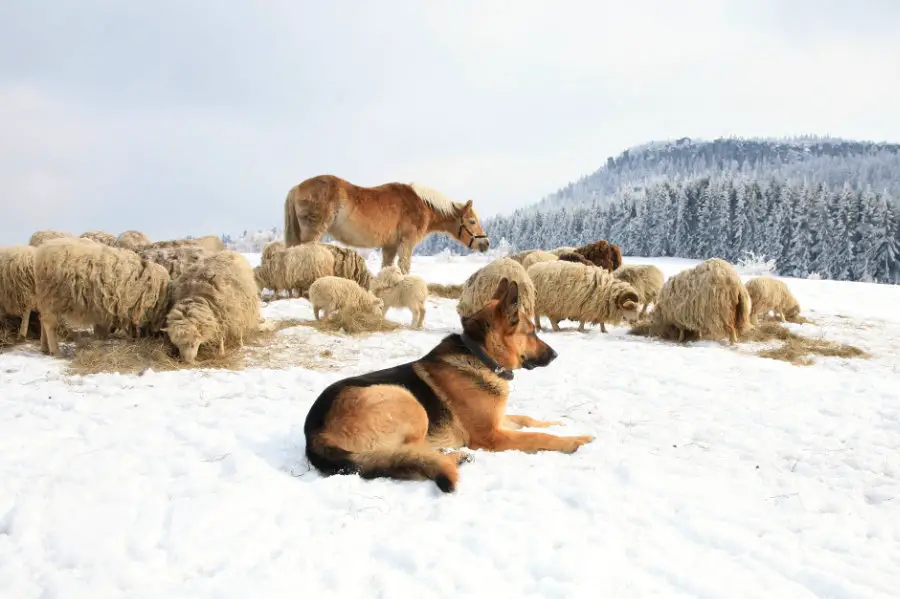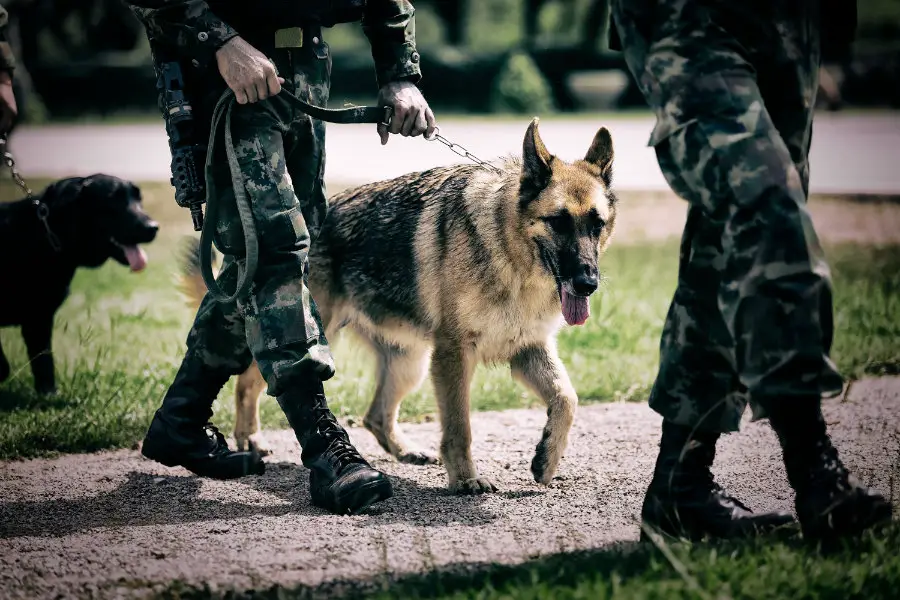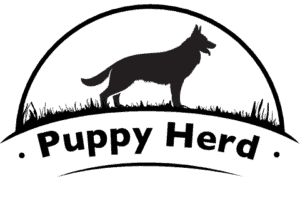Working breeds have been around for thousands of years. They have helped us to manage and protect our livestock. The German Shepherd was bred with being an all-star working dog, capable of guarding and herding livestock as well as other duties.
German Shepherds can be trained to be excellent livestock guardians and herders. Most German Shepherds have an innate talent for furrowing, which leads them to naturally patrol their area for threats. This can be highly beneficial for protecting livestock and property.
And that’s not all – not even close. The German Shepherd is an astoundingly versatile dog breed and can be trained for nearly any task that a dog is capable of. In this article, we will look at what makes German Shepherds such great livestock guardians as well as some of the other professions that they excel at.
There Is A Reason They Are Called German Shepherds

Though they are still all German Shepherds, there exist different bloodlines, or familial lines of the breed, suited for different roles. The most popular line that we see in America these days are from show lines, and they are bred for their temperament and a specific look that breeders aim for.
These show dogs would still likely make great working-class dogs if given the training and raised in the atmosphere. But what we really would look for if we were in the market for a livestock guardian is in the working lines.
These bloodlines, like the West German, Czech, and East German Working Lines are going to be as close to the original dogs that were bred by Max von Stephanitz in the late 1800s (Source). While still technically the same dog, they have a lot of different qualities that make them a shoe-in for any dog job out there.
Originally, the idea was to create the perfect dog to work on farms and manage livestock, but Germany was changing at the time, going through their industrial revolution, and suddenly, they didn’t need an all-star farm dog. So, while its roots began in working with livestock, the breed quickly transitioned into a jack-of-all-trades.
Show Dogs Vs Working Dogs
Breeding for looks was not what Stephanitz had in mind when he was working to create this famous breed. He was focused solely on creating a breed that was the top of its class as a working dog.
The recognizable, and now sought after look of the breed, came entirely as a byproduct. Along the way, as the breed grew in popularity and demand went through the roof, the bloodlines split. Now we have working and show lines. Let’s take a look at what makes them different from one another.
Show Line German Shepherds: The Choice For Families
Working dogs need a lot of exercise every single day in order to keep their minds healthy and stimulated and their muscular bodies working as they should. These types of dogs that don’t get enough exercise can suffer from a host of problems, like obesity, depression, and destructive behaviors.

As the German Shepherd breed became so popular, people wanted the look and feel of the dog, but without the hassle of a higher maintenance dog. Thus came the show lines. The characteristics of these show lines are as follows:
- Lower Prey Drive: Prey drive is the instinctual behavior that all dogs have to chase and kill prey for survival. For suburban families with cats and small children, the high prey drive of a working dog is not ideal, so the prey drive of show line German Shepherds is significantly lower than its working brethren.
- Lower Energy Drive: Along with that lowered prey drive is a lowered pool of energy reserves. German Shepherds, even when bred for show, still require regular exercise and stimulation, but it is a far cry from the requirements of working line dogs.
- Bulkier Bodies: Bigger does not mean better when it comes to work ethic. Show dogs are bred for larger, bulkier figures that show off their breed’s nuanced aesthetic. It also makes for a bigger, snugglier, bear-like dog. Who doesn’t want to snuggle a bear?
- Trademark Color Uniformity: Whereas the first German Shepherds were bred without a whole lot of consideration for looks, these show dogs certainly are. Most people that want one of these dogs want that famous black and tan coloration with a black muzzle and black “saddle.”
- Thick, Long Coats: It is not just the coloration that is important for show dogs. They also are bred to have thicker and sometimes longer coats. After all, they are being bred to look pretty and get plenty of pets and cuddles.
- Mild Temperament: These dogs have a personality and temperament that could be considered, more approachable than their working counterparts. While they still require a firm hand and proper training along with socialization, they can make great family dogs. A German Shepherd of a show lineage might rather snuggle up on the couch with the kids than wrangle a flock of sheep.
So, while they share most of their characteristics from their von Stephanitz ancestors, the show dogs are a bit softer, a bit larger, and a bit friendlier. What stands out about their cousins, the working class dogs?
Working Line German Shepherds: Ready And Able
Working dogs have helped us with our chores for as long as we’ve had to do chores. German Shepherds were made with only one thing in mind, and that is to create the perfect working dog.
So, in a bit, we’ll talk about what jobs they have done throughout their wild history. For now, let’s look at what makes the working line dogs stand out from their showy counter-dogs.
- High Prey Drive: The working lines have held onto their prey drive throughout the evolution of the breed. This gives them a built-in enthusiasm for work. They are physiologically rewarded for expending as much energy as possible, using their brilliant minds to solve problems and help their humans.
While a lot of dogs need pieces of cheese or turkey to perform even the most menial of tricks, top tier working dogs like German Shepherd love to work for the sake of work. Though, they certainly won’t turn down that cheese. - Higher Energy: That higher prey drive comes with a higher well of energy from which they can pull. Working Shepherds have a nearly boundless supply of energy when it comes to doing what they love. Their owners may need to make sure they take breaks, otherwise, they can utterly exhaust themselves.
- Well Rounded Temperament: This means that these dogs are intelligent, love to work, and work hard, and they have that vast supply of energy. They also need to be confident as the jobs in which they excel can often be dangerous and loud. At the same time, they need to be good with humans including strangers, animals, and children, while showing the utmost loyalty to their owners.
- Nerves Of Steel: German Shepherds, even in the beginning, were conscripted into military and police service. This means that they needed a certain level of confidence and a lack of fear when it came to things like gunshots, explosions, and bad guys. While a lot of dogs will cower in fear, German Shepherds need to be able to charge into the face of danger with confidence.
- Small, Strong, Swift: The working line dogs are smaller and more compact than the Shepherds you might see in movies and TV. This might seem counterproductive for a dog built for working, but it isn’t. It means that they expend less energy and are more efficient in their actions. It makes them faster and able to perform tasks that wouldn’t be possible for their larger, clumsier cousins.
- Darker Coat, Less Uniformed Coloration: While they more closely resemble their Staphanitz ancestors, you might not recognize them for a German Shepherd. That is if it wasn’t for that fluffy, long tail, mane, and trademark ears. They tend to be darker and without their black saddle and muzzle. Typically a working Shepherd can be anywhere within a range of black, tan, sable, or gray and have distinctive but random patterns.
- Shorter, Smooth Fur: The show lines have longer, silkier fur, some even having a “bear” coat. The working lines have shorter fur, which is lower maintenance and gives them a more aerodynamic profile.
- Squared And Less Sloped: Show dogs have a sloped, deeply angled posterior that puts their rear legs lower and gives them a fancier trot as they move. This is to help them prance and display their beauty. The working lines are less stooped and more powerful, lacking the show dog trot. This gives them thicker set bones and more powerful rear legs which in turn gives them better speed and power.
- More Physically Sound: By breeding for working strength and not for looks, the working lines tend to have fewer problems with genetic diseases that are increasingly common in breeds with extensive inbreeding. The working lines are much less likely, if likely at all to suffer from hip dysplasia.
They might not be outrightly recognizable as German Shepherds to the uninitiated, but these are as close to the real deal as you can get. If what you are looking for is a dog that can work the farm with you, this is the make and model to go for.
German Shepherd As A Livestock Guardian
So, we’ve gone through the differences in the lineages and how those affect their work. But how do they do with livestock? The answer is not concrete.
Yes, a German Shepherd can be a good livestock guardian, but it needs to have the right training for the job. Over a century of back and forth breeding has made a dog with a very high prey drive (in the working lines) so without the proper education, they can be overly rough on the animals that they are there to protect.
If you do truly want a German Shepherd to protect your livestock, seek out a reputable and trustworthy working line from a breeder that lets you meet the parents and watch them work. In addition, you should be ready to train the puppy from early on about how to act around livestock and prepare to be the guardian. Consider hiring a trainer who specializes in livestock dogs to help you on this journey.
A German Shepherd Might Not be the Perfect Guardian Choice
While German Shepherds are brilliant and their drive can make them excellent at nearly any role, the breed is not a livestock guardian specialist. Not anymore. They have become better at being people guardians than animal guardians, and untrained Shepherds can be rough with animals that they see as insubordinate, and deadly to animals that they see as prey.
A properly trained dog from a working line from a respected and vetted breeder can do wonders as a livestock guardian, but it might be a lot easier to look for a breed that takes to the job easier. It can save you a lot of headache and a lot of heartache.
Other breeds that protect livestock well include:
- Mastiffs
- Anatolian Shepherd
- Polish Tatra
- Komodor
- Estrela Mountain Dog
(Source)
What Jobs Are German Shepherds Good At?
German Shepherds CAN make good livestock guardians, it just isn’t what they’re best at. The saying goes, always pick the right tool for the job. You don’t want to pick a tool that is not guaranteed to be up to the task.
This feels like we are not giving the breed enough credit. They are very talented and very intelligent, and perform better than most other breeds at many jobs. Here’s a list of jobs that are perfectly suited for German Shepherds:

- Military and Police Dogs: Only the best of the best dogs are selected to work closely with police and military. The dogs that do get into the service, are almost as if they were engineered for that task alone. They excel at going after the bad guys. But they aren’t just good at apprehension. They can also detect bombs and traps, help with scouting missions, and can even be weaponized with armor and titanium fangs.
- Search And Rescue: That long snout means that they are great sniffers. German Shepherds are great at tracking which makes them great dogs for medical search and rescue. They can track lost hikers in the forest and locate victims of earthquakes, trapped beneath debris. They are hardy enough to outwork even the most steadfast humans.
- Detection Dogs: It’s not just bombs and bad guys. German Shepherds can be trained to locate any number of things. They can be used for bombs, narcotics, arson, and even as cadaver dogs, used to locate bodies of the recently, or not-so-recently deceased.
- Personal Protection Dogs: They are one of the best dogs for this task. They are amazingly loyal to their families and the people that they trust. In the face of danger, they are courageous and brave and will go above and beyond to protect their people and defend their homes. They can be trained in all manner of scenarios from home defense, to personal bodyguards.
- Service Dogs: It’s not all about taking down the bad guys. German Shepherds also make great service dogs for those in need. They are dedicated and love to help in any way they can. This means that they make excellent guide dogs, seizure dogs, and mobility assistants. They can be trained to take on multiple roles as well.
- Airport Dogs: If you’ve had a dog sniff your baggage at any airport around the world, there is a good chance that it was a German Shepherd. But it’s not just about finding drugs in suitcases, they can also help with crowd control, apprehending criminals, and keeping wildlife, like waterfowl off the runway so they don’t damage planes.
- Therapy Dogs: When they aren’t saving the world from evil, German Shepherds use their calm demeanor and loving, loyal temperament as therapy dogs. They are just as at home on the battlefield as they are snuggling up to people in need. They frequently work in hospitals, homes, and clinics to give affection to those who need it. They even help kids learn to read by sitting patiently at children’s hospitals and listening to the kids.
So, are German Shepherds good at protecting livestock? Yes, absolutely. But are they the best dog for the job? No. They can be good at nearly any task, and fantastic at many others.
One of the things they are best at is being a loyal companion. All of the things they do, they do because the reward they get is the adoration from a human that they love and respect. There isn’t much better in this world as far as a German Shepherd is concerned.
